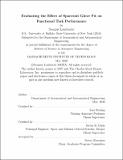| dc.contributor.advisor | Leia Stirling and Kevin R. Duda. | en_US |
| dc.contributor.author | Lombardo, Seamus(Seamus Joseph Holt) | en_US |
| dc.contributor.other | Massachusetts Institute of Technology. Department of Aeronautics and Astronautics. | en_US |
| dc.date.accessioned | 2020-11-24T17:32:03Z | |
| dc.date.available | 2020-11-24T17:32:03Z | |
| dc.date.copyright | 2020 | en_US |
| dc.date.issued | 2020 | en_US |
| dc.identifier.uri | https://hdl.handle.net/1721.1/128630 | |
| dc.description | Thesis: S.M., Massachusetts Institute of Technology, Department of Aeronautics and Astronautics, May, 2020 | en_US |
| dc.description | Cataloged from student-submitted PDF of thesis. | en_US |
| dc.description | Includes bibliographical references (pages 90-98). | en_US |
| dc.description.abstract | As the number of suited operations per mission increases with exploration beyond low Earth orbit (LEO), it is essential that crewmembers conduct suited activities in a manner that enables acceptable performance and minimizes the risk of injury. Currently, knowledge gaps exist in how to dene optimal suit t, how to more effectively incorporate fit into the suit design process, and how fit is related to performance. While it is understood that fit influences suited performance, the relationship between fit and performance has not been quantified. This research effort investigates the effects of spacesuit glove fit on tactile, dexterous, cognitive, and technical flight performance. This study adapted functional performance tasks from the literature and developed novel tasks to assess performance. Through these tasks, the hypothesis that static t (as derived from glove and human anthropometry dimensions) is related to performance in spacesuit glove was evaluated. | en_US |
| dc.description.abstract | Subjects wore prototype gloves, developed by David Clark Company, Incorporated (DCCI). These gloves are similar to the DCCI Orion Crew Survival System intravehicular activity (IVA) gloves that will be utilized on NASA's Orion spacecraft. Participants completed a battery of functional assessment tasks in a glovebox vacuum chamber (4.3 psid). The subject's prescribed fit within the DCCI glove sizing scheme specfic to this design was determined using their anthropometry. The subjects then conducted the tasks in gloves one size below their prescribed fit, their prescribed fit size, and gloves one size larger than their prescribed t in both a pressurized and unpressurized state. To evaluate general tactility, blindfolded subjects attempted to detect bumps of dierent widths (0.59 in, 0.39 in, 0.20 in) and heights (0.05 in, 0.20 in,0.39 in) while the correct detection was recorded. An operationally-relevant tactility task was also designed. | en_US |
| dc.description.abstract | A mock spacecraft control panel was created in consultation with subject matter experts and designed to NASA specification. Blindfolded subjects then actuated a pre-defined sequence of these controls on the switchboard. The accuracy and completion time of the sequence was recorded. To evaluate general dexterity, subjects completed a pegboard task, which required moving and rotating pegs between locations on the board. Dexterity was also measured using a functional tool task where subjects attached and detached an extravehicular activity (EVA) tether hook to fixtures designed to NASA specification. For both dexterity tasks completion time was recorded. The Draper real-time performance metrics workstation lunar landing simulator was used to assess technical flight performance and mental workload (through a secondary task response time measure). | en_US |
| dc.description.abstract | It was found that direct measures of static fit derived from hand length and glove length had a signicant relationship to performance on the switchboard tactility task. Additionally, it was found that in the unpressurized case, subjects performed significantly better on the switchboard task when wearing the glove size larger than the prescribed fit as compared to small and prescribed fit. No consistent signicant relationships with respect to glove sizing were found for the dexterity tasks or the the lunar landing simulator task. This study also rearms tactile and dexterous performance decreases with a spacesuit glove pressurization, with tactile performance also decreasing with the addition of unpressurized gloves over barehanded conditions. | en_US |
| dc.description.statementofresponsibility | by Seamus Lombardo. | en_US |
| dc.format.extent | 98 pages | en_US |
| dc.language.iso | eng | en_US |
| dc.publisher | Massachusetts Institute of Technology | en_US |
| dc.rights | MIT theses may be protected by copyright. Please reuse MIT thesis content according to the MIT Libraries Permissions Policy, which is available through the URL provided. | en_US |
| dc.rights.uri | http://dspace.mit.edu/handle/1721.1/7582 | en_US |
| dc.subject | Aeronautics and Astronautics. | en_US |
| dc.title | Evaluating the effect of spacesuit glove fit on functional task performance | en_US |
| dc.type | Thesis | en_US |
| dc.description.degree | S.M. | en_US |
| dc.contributor.department | Massachusetts Institute of Technology. Department of Aeronautics and Astronautics | en_US |
| dc.identifier.oclc | 1205581980 | en_US |
| dc.description.collection | S.M. Massachusetts Institute of Technology, Department of Aeronautics and Astronautics | en_US |
| dspace.imported | 2020-11-24T17:32:02Z | en_US |
| mit.thesis.degree | Master | en_US |
| mit.thesis.department | Aero | en_US |
